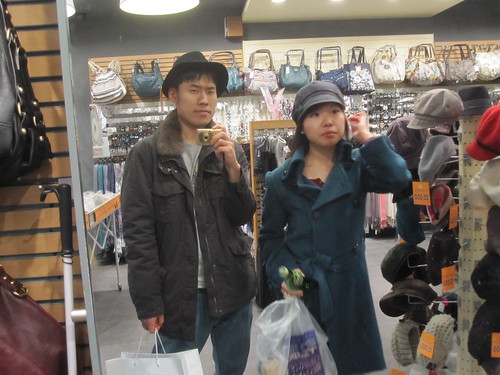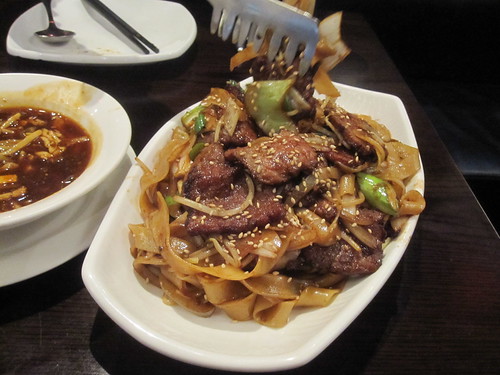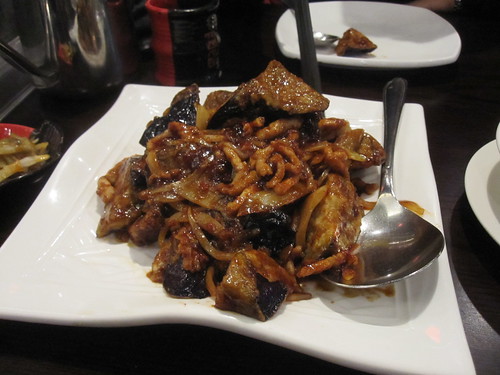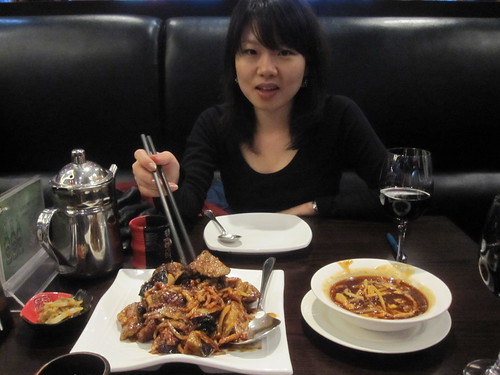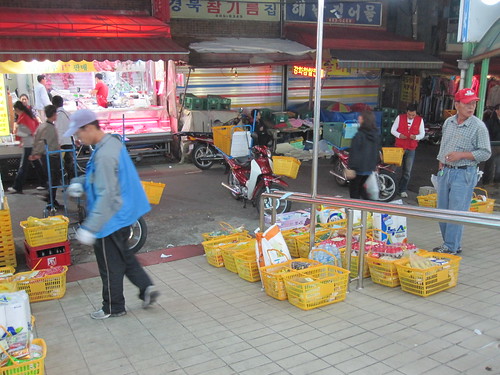Tuesday, March 30, 2010
Quote Dump #3
Sunday, March 28, 2010
COEX and Ho Lee Chow
After our visit to the Mario Outlets at Gasan Digital Complex, my mind (which habitually strives for logical ideas) has developed a new appeciation for fashion. Is this normal for a poverty stricken molecular biology student who grew up on hand-me-downs and is proud of the various stains on his white labcoat?
Sure, I think.
There's a fuzzy line between what consitutes unreasonable spending to compensate for social insecurities versus creative representation of personal identity. I guess that particular fuzzy line is defined by how much your wife is willing to let you spend. Heather and I almost never wear hats, because it seems that we weren't endowed with heads that complement them very well. Except for when I wear my wide-brimmed farmer's hat while inoculating down in the rice fields of Suwon.
But that's specifically to keep the sun off my noggin, not to impress the fantastic agricultural ajummas who patrol the area in gumboots.
This young shop assistant at COEX was energetically explaining to me that I was not to take photos in their shop, and she would have been indecipherable had I tried to understand from her hand signals alone. Because we just had a pitcher of beer in a bar called Jug, I was feeling a little silly. So I played the wide-eyed foreigner card and pretended to misinterpret her instructions into thinking that she wanted me to take a photo of her. Hilarity ensued.
Delicious Chinese cuisine has infected the world like a benevolent virus. The early immigrants to the first Chinatowns overseas went through many hardships and it's likely that their cooking skills played a critical role in helping them to respectfully survive in their new home countries. The flavours of authentic Chinese cooking across the globe changed as cooks adapted to local preferences and regional ingredients. Interesting self-reflections of the host country can now be seen in many dishes, from fried ice cream to pineapple cooked with chow mein.
Ho Lee Chow is an American Chinese restaurant chain with a few outlets around Seoul. They're one of a very few number of establishments willing to sell Chinese food that consists of things other than jajangmyeon, which is the Korean interpretation of Shandong fried noodles. Funnily enough, Korean style jajangmyeon is becoming popular as a foreign food in China.
American Chinese food has also evolved from its origins, with dishes like sweet and sour pork, lemon chicken and Szechuan beef being staple favourites. These are all available at Ho Lee Chow, along with a complimentary pot of black tea. The photo above shows their interpretation of beef char kway teow, which we ordered out of pure curiousity.
Char kway teow, being a dish we specialised in at the Casuarina Malaysian Bistro, is difficult for me to consume without a degree of overanalysis. To be nice, these ones weren't too bad, but realistically they fell short of the real deal. They had a fairly good smokey flavour from a high wok temperature and the beef was quite good. But the noodles suffer from being reconstituted from the dried import form and there was an overabundance of two kinds of onion. Char kway teow really needs fresh noodles like those from Taings.
Still, they get full marks for being the first place in Korea to offer the dish in the first place.
The other main dish that we ordered was fried aubergine. I like using the word aubergine as much as I like using courgette. This was quite good, with a tangy base for the sauce and not overly greasy from the deep fryer. The trick for crispy rather than greasy foods is to make sure the oil is searing hot when you pull the food out of it. That way it will be highly motile and can be easily drained with a sieve. Colder oil sticks to the food due to its viscousity at lower temperatures.
We also ordered hot and sour soup, a personal favourite. This was also done well and I enjoyed the bamboo shoots. Heather quite liked the food here and the service was quick and friendly. For those missing Chinese flavours from home, Ho Lee Chow is worth a visit.
After eating slightly more than is reasonable for two married primates, we walked around to find a nice place to sit back and digest. We found this bar in the basement floor of the nearby MyThai restaurant, called MyBed. It was opened recently by the same owner, Hong Seok-Cheon, an actor who stunned our quaint little peninsula a decade ago by becoming the first South Korean actor to come out as a gay man. He was shunned by the industry and much of the public and soon found himself unable to get employment. So he opened a restaurant, and then a karaoke bar and has since become highly successful with multiple renowned establishments to his name.
Well, good on him, too.
Oh, and the cocktails here are pretty good.
Saturday, March 27, 2010
Quote Dump #2
"Yeah, apparently a teacher in Britain was arrested. On him they found a pencil, eraser, ruler, protractor and compass. They said he was part of the Al Gebra network, and that he had weapons of math instruction!"
Thursday, March 25, 2010
Earth Hour 2010
This Saturday is Earth Hour, a global event run by the Worldwide Fund for Nature. The idea is for people to turn off their non-essential electrical appliances and lights from 8:30pm until 9:30pm local time this Saturday, March 27th.
Last year, 88 countries and 4,088 cities across the world participated. The Philippines alone saved 611 MWh of electricity during the event, which is estimated to be the equivalent of shutting down a dozen coal-fired power stations for an hour.
While the economic benefits of such an event may be difficult to calculate, the main idea is to raise awareness towards the need to take action on climate change. And it's fun to participate in something like this on a global scale.
Even North Korea is getting in on the act. I guess they'll be turning off their tower of the Juche Idea for an hour.
Well, good on them, anyway.
Wednesday, March 24, 2010
Convenience Culture
One of the biggest (+)'s of living in Korea is the culture of convenience. Restaurants will send ajossis on scooters to your door without a delivery charge (even if you only order a $3 kimchijjigae), and come back later to collect the plates. They even deliver McDonald's here. If you order something online from a Korean company, expect it to arrive at your doorstep within a couple of days.
Down at the old rickety Wondang Markets the breezes of modernisation are slowly wafting in to this back alley of commerce. The singular and otherwise unremarkable not-so-super-market of the area now offers free home delivery of groceries. All you have to do is buy at least $30 worth of stuff, pile it into a basket and write your address and phone number on an attached piece of paper. The ajossis will then look at the papers and put the baskets in different rows according to location. Although in true ajossi fashion, they do feel the urge to over-complicate the operation by debating with each other as to the optimal placement of delivery basket.
When Operation Placement of Basket has been completed, you can do some further shopping or go straight home without having to carry your milk, juice and rice with you. The basket will arrive at your house around 2 hours later, complete with a tobacco-fragranced annyeonghaseyo.
My prediction for the year 2035 is that Korea will be the first country to start using delivery scooter-robots.
Tuesday, March 23, 2010
Quote Dump #1
"You don't have to run faster than the bear. You just have to run faster than your brother."
During my middle school years in Australia (I refer to them as the roaring 90's), I started collecting quotes online. I had a public chatroom on Internet Relay Chat called #ponder, where a semi-feeble effort was undertaken to encourage people to talk about things more interesting than what age we were (age), whether we were male/female (sex) and where we lived (location). These three questions were often summed up by users in the singular question 'a/s/l?', which is a substitute for 'hello' in the world of IRC.
"Quickly, bring me a beaker of wine, so that I may wet my mind and say something clever."
~Aristophanes
To sow the seeds of thoughtfulness for any guests willing enough to enter, I often posted a quote of the day that would greet them in purple banner text on the title bar.
"No man ever steps in the same river twice, for it's not the same river and he's not the same man."
~Heraclitus
It's funny how a good quote will bring with it a light air of pseudo-authority, merely because it's a quote. The worst ones are those that are long winded and lack substance. Anyway, what happened after middle school was that I ended up losing that hard drive and my entire quotes collection.
"Give a man a fire and he'll stay warm for a day.
Set a man on fire and he'll stay warm for the rest of his life."
Which was probably a good thing. I had them all on a huge notepad file that took forever to scroll down. Kind of like a disorganised closet. And just like how I used to read the newspaper everyday, once it was gone I realised it was entirely unnecessary.
"Be still and know."
~Thich Nhat Hanh
Anyhow, in complete contradiction to that realisation I started putting some of the more memorable quotes on Facebook. I'm going to cross post them here from time to time, in a feature called Quote Dump. Hopefully then, they'll be safer than in my brain and it's more fun to share them anyway.
"You know, Hobbes, some days even my lucky rocketship underpants don't help."
~Calvin
During my middle school years in Australia (I refer to them as the roaring 90's), I started collecting quotes online. I had a public chatroom on Internet Relay Chat called #ponder, where a semi-feeble effort was undertaken to encourage people to talk about things more interesting than what age we were (age), whether we were male/female (sex) and where we lived (location). These three questions were often summed up by users in the singular question 'a/s/l?', which is a substitute for 'hello' in the world of IRC.
"Quickly, bring me a beaker of wine, so that I may wet my mind and say something clever."
~Aristophanes
To sow the seeds of thoughtfulness for any guests willing enough to enter, I often posted a quote of the day that would greet them in purple banner text on the title bar.
"No man ever steps in the same river twice, for it's not the same river and he's not the same man."
~Heraclitus
It's funny how a good quote will bring with it a light air of pseudo-authority, merely because it's a quote. The worst ones are those that are long winded and lack substance. Anyway, what happened after middle school was that I ended up losing that hard drive and my entire quotes collection.
"Give a man a fire and he'll stay warm for a day.
Set a man on fire and he'll stay warm for the rest of his life."
Which was probably a good thing. I had them all on a huge notepad file that took forever to scroll down. Kind of like a disorganised closet. And just like how I used to read the newspaper everyday, once it was gone I realised it was entirely unnecessary.
"Be still and know."
~Thich Nhat Hanh
Anyhow, in complete contradiction to that realisation I started putting some of the more memorable quotes on Facebook. I'm going to cross post them here from time to time, in a feature called Quote Dump. Hopefully then, they'll be safer than in my brain and it's more fun to share them anyway.
"You know, Hobbes, some days even my lucky rocketship underpants don't help."
~Calvin
Monday, March 22, 2010
Time to Evolve - Again
My first entry on this blog is dated July 20th, 2006. That was a couple of days before I arrived in the land of morning motorway congestion. At the time I can remember I was wondering how long it would last. The original aim was to keep people back home informed without having to send emails, and also to serve as a more permanent online record of this part of my life. Also I was greatly inspired by a blog called the Korea Life Blog, which I appreciated for its matter-of-fact glimpse of life in Korea for the average person.
Overall I'm fairly happy that I've kept my blog going this long, and I sometimes flick back with a glass of wine when I'm in a nostalgic mood. Apart from friends and family who read it, most of my traffic comes through Google searches by people wanting to read about Korea.
I saw a TED talk today by Gary Vaynerchuck and he suggested that whatever we do online now is likely to stay around for countless generations of our descendants to read. With the plummeting price of data storage, I think that's entirely likely.
So I think I'm going to expand the scope of my humble little blog into a blend of life in Korea, as well as other things and thoughts that I come across. Hopefully it'll become a more colourful record of life in general, instead of specifically Korea-related things.
My Dad thinks my blog is great, so that's encouraging. But then again he thinks lots of things are great, including earthworms. He's a philosopher and is currently writing a paper for publication called A New, Objective, Pro-Objectivity Normative Theory. It's too verbose for my synapses to comprehend. Once he publishes it, you can all read it online for free. Now see, that little piece of information right there is something that wouldn't have been posted on the Old Lee's Korea Blog, because it doesn't pertain to life in Korea. But in LKB Ver 2.1, you'll be hearing about all sorts of things. For better or worse.
At least I know Dad will be reading it...
Overall I'm fairly happy that I've kept my blog going this long, and I sometimes flick back with a glass of wine when I'm in a nostalgic mood. Apart from friends and family who read it, most of my traffic comes through Google searches by people wanting to read about Korea.
I saw a TED talk today by Gary Vaynerchuck and he suggested that whatever we do online now is likely to stay around for countless generations of our descendants to read. With the plummeting price of data storage, I think that's entirely likely.
So I think I'm going to expand the scope of my humble little blog into a blend of life in Korea, as well as other things and thoughts that I come across. Hopefully it'll become a more colourful record of life in general, instead of specifically Korea-related things.
My Dad thinks my blog is great, so that's encouraging. But then again he thinks lots of things are great, including earthworms. He's a philosopher and is currently writing a paper for publication called A New, Objective, Pro-Objectivity Normative Theory. It's too verbose for my synapses to comprehend. Once he publishes it, you can all read it online for free. Now see, that little piece of information right there is something that wouldn't have been posted on the Old Lee's Korea Blog, because it doesn't pertain to life in Korea. But in LKB Ver 2.1, you'll be hearing about all sorts of things. For better or worse.
At least I know Dad will be reading it...
Tuesday, March 16, 2010
Mario Outlet - Shopping at Gasan Digital Complex
Modern architecture in Korea is pretty good around the Gangnam area. I don't know much about art in general, but I appreciate buildings that look nice. Science is useful and art is aesthetic, so I guess architecture is one of those times when the two fields meet.
The other time would be when they make fluorescent rabbits.

This jellied monstrousity is a work-in-progress near Gangnam Station exit 6. I heard that curved skyscrapers are much better at deflecting wind, although I don't think that's the basis for this design.
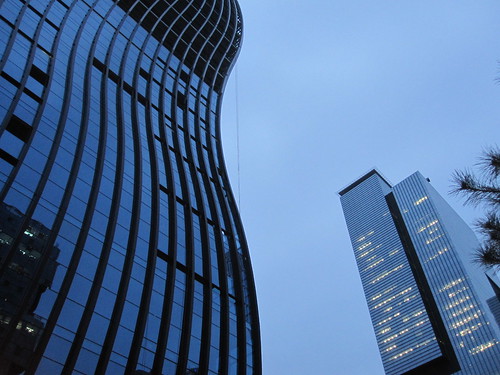
The city council seems to have zoning regulations for new buildings, requiring them all to have a similar metallic sheen around Samsung Headquarters. It's nice to see the reflections of the clouds in the buildings, but I was once caught in the dazzling glare of the sun's reflection. That's a possible traffic hazard to watch out for.
If they angled the buildings properly, they could deflect sunlight onto urban vegetable gardens and grow things nearby. I, for one, would happily eat Samsung Sunlight Cabbages™.
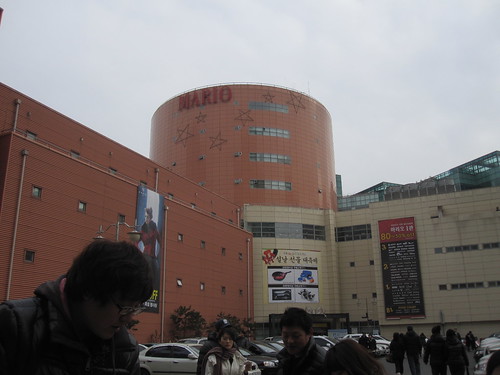
I heard that in the 90's clothing in Korea was cheap. Friends would come back to Australia with bags full of counterfeit designer clothing as well as pirated VCDs. Since then the government has clamped down on fake brands, probably due to pressure from trading partners. Prices for regular clothing now is very similar to what you find in Australia.
Gasan Digital Complex is a clothes shopping district near the subway station of the same name. As often happens in Korea, a whole lot of the same kind of shops are all conveniently bundled into the same area. What makes this place different is that they have a number of outlet buildings stocking discounted clothing.

You can get there by catching the subway to the Gasan Digital Complex station and walking straight out of exit 4. Considerable discounts are offered because the merchandise is surplus stock from retailers or out of season. It's like a big dumping ground for all the clothes that the retailers don't want to sell. If you have a lot of clothes shopping to do, I'd recommend heading down there.
There's also a Value Added Tax refund for foreigners. If you buy something over W30,000 and depart within 3 months, you get your VAT back when you depart.
There's more information on this website.

Growing up with a family of four children meant that a lot of the old hand-me-downs came my way. Sporting the family heirlooms at school didn't bother me too much, although any designer brands that we kids had were highly prized possessions.
The average discounts at the Mario Outlets are around 40-60% off.
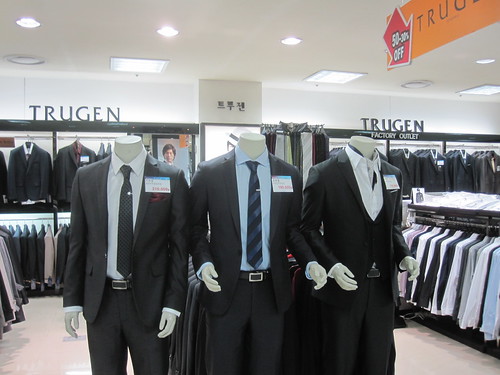
There's enough floor space in the various buildings to spend the entire day, if you like shopping. In the end we spent around US$400, but now we'll probably be fine until next year. On their website it says that at the end of every year they have a mega sale and merchandise has a 90% discount.
Which makes you wonder where the other 90% of your money goes when you buy it at a department store.

I've been collecting a few photos of public spelling errors on my trusty handycam lately. I'll post a summary of them all soon. Someone once told me that there was a lawsuit in the States where a lady spilled hot McDonald's coffee on herself and successfully sued the company for damages. The accusation was that she was not adequately warned on the label that coffee was hot. Since then, coffee cup makers everywhere have been obliged to put cautionery warnings on their cups. It's for all those first timers who have never ordered a hot coffee before.
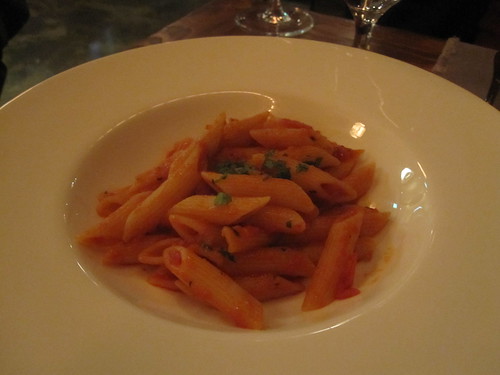
There's a new Italian restaurant near us called Trattoria, that recently opened up. It's worth a mention because the cooks are Italian and the food seems to be authentic. This arrabiata was lightly sauced but well flavoured. They also sell table and house wine, in carafe and half carafe sizes. That fact alone sets it apart from your overzealously decorated local Sorrento.
The only Koreanification detectable was a little jar of pickles that reluctantly came with the main course. An Italian restaurant in Seoul that doesn't serve pickles is brave indeed.
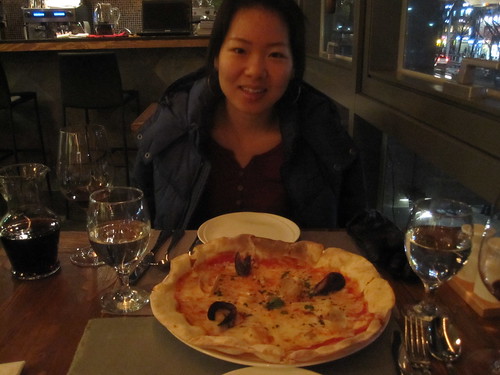
We also had the Pizza Il Mare, which had excellent dough and good cheese. It cost us around $30 for this meal and we'll probably go back sometime. It's not worth making a special trip out for, but it's the best Italian food in the SNU area. To find Trattoria, take exit 2 at Seoul National University station and walk up the road (past KFC) for about 50 metres. It's on the second floor above Cold Stone Ice Creamery.
And if you've got the time, have a read of an Italian Chef's experience of cooking pizza for Kim Jong Il (Part 1, Part 2, Part 3).
The other time would be when they make fluorescent rabbits.

This jellied monstrousity is a work-in-progress near Gangnam Station exit 6. I heard that curved skyscrapers are much better at deflecting wind, although I don't think that's the basis for this design.

The city council seems to have zoning regulations for new buildings, requiring them all to have a similar metallic sheen around Samsung Headquarters. It's nice to see the reflections of the clouds in the buildings, but I was once caught in the dazzling glare of the sun's reflection. That's a possible traffic hazard to watch out for.
If they angled the buildings properly, they could deflect sunlight onto urban vegetable gardens and grow things nearby. I, for one, would happily eat Samsung Sunlight Cabbages™.

I heard that in the 90's clothing in Korea was cheap. Friends would come back to Australia with bags full of counterfeit designer clothing as well as pirated VCDs. Since then the government has clamped down on fake brands, probably due to pressure from trading partners. Prices for regular clothing now is very similar to what you find in Australia.
Gasan Digital Complex is a clothes shopping district near the subway station of the same name. As often happens in Korea, a whole lot of the same kind of shops are all conveniently bundled into the same area. What makes this place different is that they have a number of outlet buildings stocking discounted clothing.

You can get there by catching the subway to the Gasan Digital Complex station and walking straight out of exit 4. Considerable discounts are offered because the merchandise is surplus stock from retailers or out of season. It's like a big dumping ground for all the clothes that the retailers don't want to sell. If you have a lot of clothes shopping to do, I'd recommend heading down there.
There's also a Value Added Tax refund for foreigners. If you buy something over W30,000 and depart within 3 months, you get your VAT back when you depart.
There's more information on this website.

Growing up with a family of four children meant that a lot of the old hand-me-downs came my way. Sporting the family heirlooms at school didn't bother me too much, although any designer brands that we kids had were highly prized possessions.
The average discounts at the Mario Outlets are around 40-60% off.

There's enough floor space in the various buildings to spend the entire day, if you like shopping. In the end we spent around US$400, but now we'll probably be fine until next year. On their website it says that at the end of every year they have a mega sale and merchandise has a 90% discount.
Which makes you wonder where the other 90% of your money goes when you buy it at a department store.

I've been collecting a few photos of public spelling errors on my trusty handycam lately. I'll post a summary of them all soon. Someone once told me that there was a lawsuit in the States where a lady spilled hot McDonald's coffee on herself and successfully sued the company for damages. The accusation was that she was not adequately warned on the label that coffee was hot. Since then, coffee cup makers everywhere have been obliged to put cautionery warnings on their cups. It's for all those first timers who have never ordered a hot coffee before.

There's a new Italian restaurant near us called Trattoria, that recently opened up. It's worth a mention because the cooks are Italian and the food seems to be authentic. This arrabiata was lightly sauced but well flavoured. They also sell table and house wine, in carafe and half carafe sizes. That fact alone sets it apart from your overzealously decorated local Sorrento.
The only Koreanification detectable was a little jar of pickles that reluctantly came with the main course. An Italian restaurant in Seoul that doesn't serve pickles is brave indeed.

We also had the Pizza Il Mare, which had excellent dough and good cheese. It cost us around $30 for this meal and we'll probably go back sometime. It's not worth making a special trip out for, but it's the best Italian food in the SNU area. To find Trattoria, take exit 2 at Seoul National University station and walk up the road (past KFC) for about 50 metres. It's on the second floor above Cold Stone Ice Creamery.
And if you've got the time, have a read of an Italian Chef's experience of cooking pizza for Kim Jong Il (Part 1, Part 2, Part 3).
Sunday, March 07, 2010
A Nintendo Wii and a Mouldy Shoe
Every once in a while, fortune smiles upon the Farrand household in Seoul. Two relatives of Heather's and technically of mine now (although I haven't gotten quite used to the fact), sent us a Nintendo Wii in the mail. Heather had mentioned off-hand to them that 'the only thing our place is lacking is a Wii.' Two weeks later, one arrives at our doorstep.
If I become rich one day, remind me to send Wii's to everyone I know.
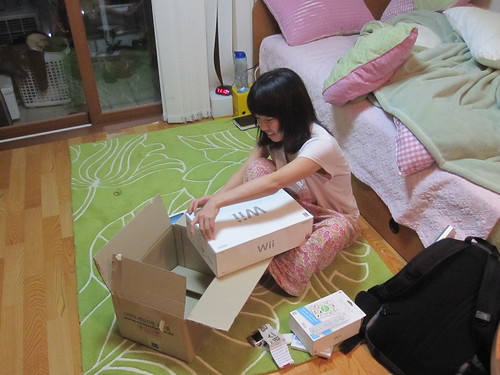
The name Wii is a little odd, and is pronounced 'We'. It alludes to the idea that it's supposed to be played with friends. The double 'i' was chosen to represent the outlines of two people standing next to each other. I guess it would have been an interesting situation at Nintendo's headquarters for the person who proposed the name, waiting for the reactions of the executives.
It has broken numerous records over the past few years and more than 67 million units have been sold.

Before playing, Heather dutifully called her relatives, who shall now be collectively referred to as GOW (Givers Of Wii).
They're actually Heather's second eldest sister and her husband.
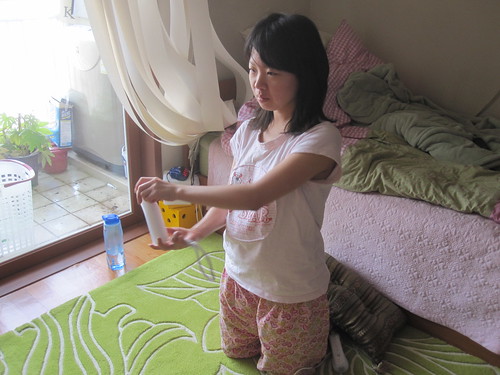

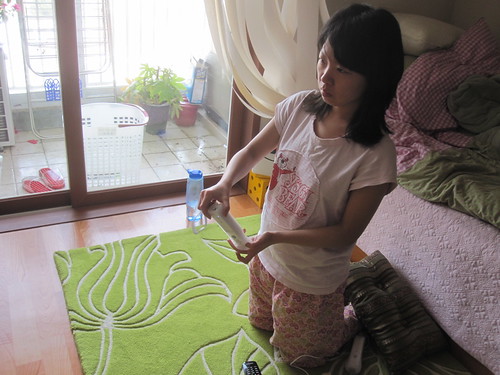
Those of you who are under 35 probably know about the Wii already. But I'm pretty sure my Dad doesn't and he reads this blog regularly, so I need to explain. The Wii's innovation is in its controller, which captures the motion of the person who holds it. So instead of just pressing buttons, you also need to move your body to control the game.
Is it a substitute for exercise? Well, not really.
But it's fun.

In this cow-riding game on Wii Play, you need to lean with the controller to turn corners. For obstacles that you have to jump over, you flick the controller up quickly.
The novelty of it all wears off after a while, but we'll still be using it for a long time.

Now this is an interesting gauge of how dramatic my life is. A habit I picked up from my Dad is keeping shoes for an exceptionally lengthy period of time. My Dad would wear shoes until they developed gaping holes, only discarding them if they fell off his feet.
The laces of my old shoes withered away and so I replaced them with different ones. The new laces didn't quite match, but for a time, things were grand. Then a hole started developing in the sole. Hey, that rhymes. The hole let water in and got my socks a little mucky, so I put the shoes in our recycling box for possible repairs at a later date. Incidentally, there is also a can of VB in there, which is Australian beer now available at our local GS supermarket. Anyway, because the recycling box is left out at the mercy of the forces of nature, the next time I looked, one of the shoes had become mouldy. This led me to ponder the question: What would be the meaning of life if you lived on a shoe?
And more importantly, can you recycle mouldy footwear?
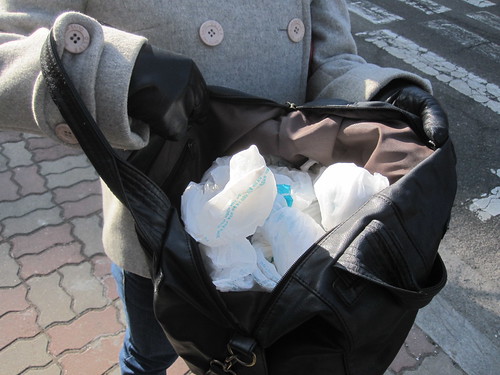
GS Supermarket charges 50 won (5 cents) for a shopping bag these days. It's generally a good idea and designed to encourage customers to bring their own bags. Excess shopping bags in the world are contributing to the Great Pacific Garbage Patch, an enormous perpetually circulating mass of floating rubbish in the North Pacific. Estimates of its size range from 700,000 square kilometres to twice the size of the continental United States.

We always keep our bags, for various reasons. One thing I didn't know was that you can bring them back to the supermarket and get a full refund for them. I found this out after enquiring as to why Heather's handbag was looking like a bloated hippo.
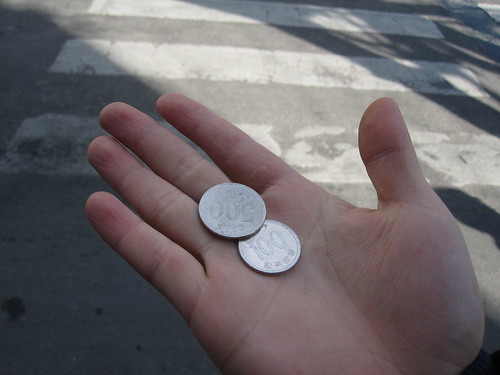
We had twelve bags in total and got about 60 cents back. It reminded me of my Scouting days when we used to collect bottles to raise money for our troop.
If you're in Korea and you know someone with a drawer full of shopping bags, tell them that they're sitting on a gold mine.

Our dormitory room is a little cramped and only designed for one occupant. But we seem to get by okay. The photo above is showing Heather's preferred way to watch television, on a single bed. Apparently it's the most comfortable position for extended periods of time.
Enjoy your week everyone.
If I become rich one day, remind me to send Wii's to everyone I know.

The name Wii is a little odd, and is pronounced 'We'. It alludes to the idea that it's supposed to be played with friends. The double 'i' was chosen to represent the outlines of two people standing next to each other. I guess it would have been an interesting situation at Nintendo's headquarters for the person who proposed the name, waiting for the reactions of the executives.
It has broken numerous records over the past few years and more than 67 million units have been sold.

Before playing, Heather dutifully called her relatives, who shall now be collectively referred to as GOW (Givers Of Wii).
They're actually Heather's second eldest sister and her husband.



Those of you who are under 35 probably know about the Wii already. But I'm pretty sure my Dad doesn't and he reads this blog regularly, so I need to explain. The Wii's innovation is in its controller, which captures the motion of the person who holds it. So instead of just pressing buttons, you also need to move your body to control the game.
Is it a substitute for exercise? Well, not really.
But it's fun.

In this cow-riding game on Wii Play, you need to lean with the controller to turn corners. For obstacles that you have to jump over, you flick the controller up quickly.
The novelty of it all wears off after a while, but we'll still be using it for a long time.

Now this is an interesting gauge of how dramatic my life is. A habit I picked up from my Dad is keeping shoes for an exceptionally lengthy period of time. My Dad would wear shoes until they developed gaping holes, only discarding them if they fell off his feet.
The laces of my old shoes withered away and so I replaced them with different ones. The new laces didn't quite match, but for a time, things were grand. Then a hole started developing in the sole. Hey, that rhymes. The hole let water in and got my socks a little mucky, so I put the shoes in our recycling box for possible repairs at a later date. Incidentally, there is also a can of VB in there, which is Australian beer now available at our local GS supermarket. Anyway, because the recycling box is left out at the mercy of the forces of nature, the next time I looked, one of the shoes had become mouldy. This led me to ponder the question: What would be the meaning of life if you lived on a shoe?
And more importantly, can you recycle mouldy footwear?

GS Supermarket charges 50 won (5 cents) for a shopping bag these days. It's generally a good idea and designed to encourage customers to bring their own bags. Excess shopping bags in the world are contributing to the Great Pacific Garbage Patch, an enormous perpetually circulating mass of floating rubbish in the North Pacific. Estimates of its size range from 700,000 square kilometres to twice the size of the continental United States.

We always keep our bags, for various reasons. One thing I didn't know was that you can bring them back to the supermarket and get a full refund for them. I found this out after enquiring as to why Heather's handbag was looking like a bloated hippo.

We had twelve bags in total and got about 60 cents back. It reminded me of my Scouting days when we used to collect bottles to raise money for our troop.
If you're in Korea and you know someone with a drawer full of shopping bags, tell them that they're sitting on a gold mine.

Our dormitory room is a little cramped and only designed for one occupant. But we seem to get by okay. The photo above is showing Heather's preferred way to watch television, on a single bed. Apparently it's the most comfortable position for extended periods of time.
Enjoy your week everyone.
Wednesday, March 03, 2010
Ben's Wedding and some Confocal Microscopy
Nearly half a year has passed since Heather and I got married in Busan. And if you're not yet married and wondering "So how's married life?" well, it's really similar to life before marriage. Getting married is a good thing overall, but just make sure you choose the right person. Luckily, I did.
Not sure whether she did though...

Ben is a Canadian teacher at Heather's new CDI branch and we were invited to the wedding. Heather has only been working a couple of months and I'd never met any of the teachers from the branch before, so it was a nice gesture. The ceremony was held at a wedding hall (I think the name was Suaviss) north of the river.

I heard a one-liner the other day about a woman saying to her best friend "For 18 years my husband and I were the happiest people on Earth. Then we met."
I found it funny, but anyhow I hope Ben and his new wife have a rewarding life together.
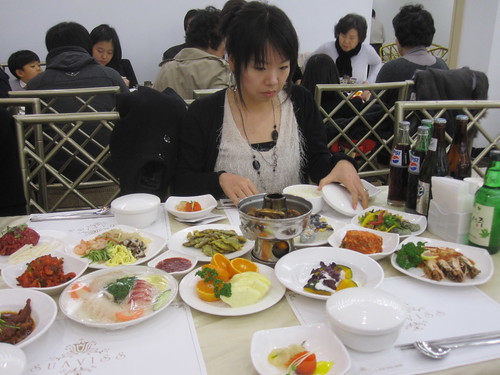
If you don't know the bride and groom very well, the best thing about going to a wedding is free food and alcohol. In Korea I guess it's not really free, because all the guests will typically give the couple some money as a gift. A regular amount of money to give would be W50,000 (about US$50). Any more than that is being generous, while anything less is being a bit of a scrooge and only forgivable if you're a grad student.
And yes, they do record your name and how much you gave. Forensic examination of the records afterward constitutes half the fun of getting married.
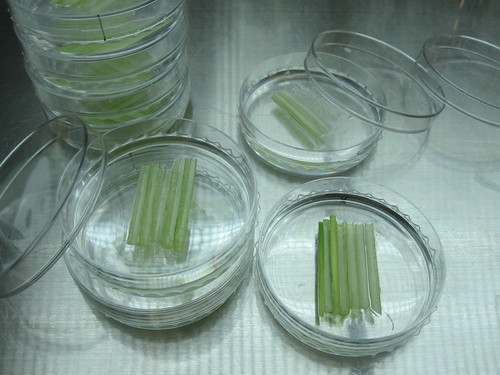
So let's go back to the lab and see what's going on. These days I'm doing three experiments simultaneously, two of which are not going so well. The one that is working is an ongoing microscopy experiment, which has evolved into using tobacco and rice cells. Earlier this year I managed to get fluorescence in onion cells by microparticle bombardment, but that has since become child's play. I remember the first time I saw fluorescent green in an onion, I literally ran up the stairs to tell Rakshya "I've got signal!"
Now I've seen more than 100 fluorescent images and it's not nearly as exciting.

This photo shows my preparation of a rice xylem tube, which can be thought of as a vein that water travels through. Rice is an exceedingly difficult plant to work with. It happens to have every possible element that a plant could have to make it difficult to study. It repels water (and dye), emits light in every wavelength, falls to pieces when finely cut and starts rearranging its cellular 'gizzards' as soon as you put it on a slide. My teaching instincts normally tell me to discipline such an unruly subject, but in this case it would be counter-productive.
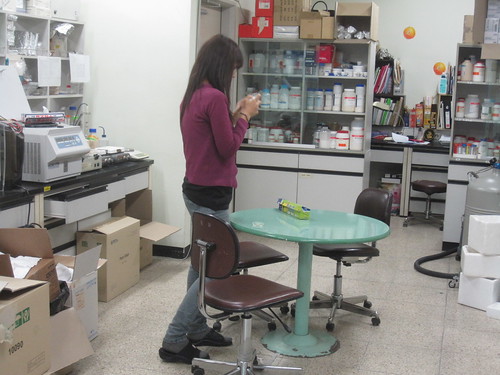
This is Rakshya Singh in her lab at Sejong University. She's a Nepalese PhD student working on Magnaporthe oryzae, a rice fungus. We're starting to collaborate on experiments and it's great to have someone that I can discuss things with.
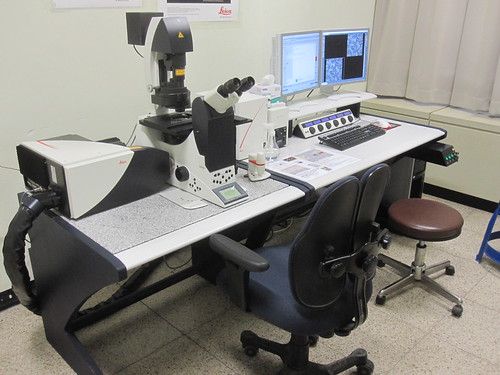
They also have a confocal microscope, which I use nearly every week. Most Fridays I will pack some plants into a box and travel across town to their university so I can use it. Confocal microscopes are sensitive pieces of equipment and typically cost around US$350,000.
Normal optical microscopes illuminate whatever you're looking at with a backlight, which is fine for simple images, but what you see is a collection of everything that the light passes through. So if you imagine yourself looking straight down at a small opaque man standing on the slide with a hat on, the image you get would show every cross section from his shoes to his hat, all on top of each other. This would make it very difficult to tell what kind of socks he's wearing, for instance. A confocal microscope gets around this by splitting two laser beams and using them as the light source. This allows high precision imaging of any cross section that you want to focus on. You can even take photos of multiple layers in a cell and stitch them together into a 3D image.

This isn't my picture, but it's in the public domain as a patent application so I guess that means I can use it. It shows the basic idea of a confocal microscope, which was invented by Marvin Minsky. Surprisingly, he came up with the idea 30 years too early and it wasn't until lasers became readily available that the concept became feasible.
The straight lines are showing the paths of light being bent and deflected by mirrors and a lens.

And this is the kind of image that you get with a confocal microscope. These are my tobacco cells, after having been attacked with a bacterial strain called Agrobacterium tumefaciens. Before setting the critters loose, I inserted some engineered DNA into them, which causes the cells that they attack to turn bright green.
Tobacco cells are rather oddly shaped, I find.
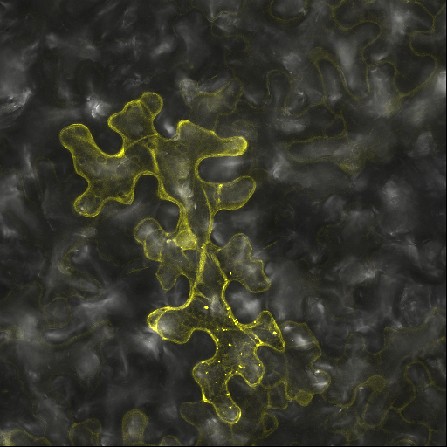
And this is something similar but more interesting. It's a tobacco cell displaying Bi-molecular Fluorescence Complementation. In science terms we would say that it's showing the reconstitution of a fluorophore. In everyday language that means we broke our glowing molecule into two halves, and inserted them separately into the cell. The cell will turn yellow if the two halves find each other. If it doesn't glow it means that they didn't meet up. So this experiment is one of the minority that I'm having success with at the moment. In the bigger picture, this provides evidence that my two proteins are interacting in the plant. One is a bacterial toxin and the other is a plant protein, and I'm trying to figure out what's going on in the grand scheme of things.
Science is all about hits and misses, and keeping good records of both. Hopefully this year will be more fruitful than last.
Not sure whether she did though...

Ben is a Canadian teacher at Heather's new CDI branch and we were invited to the wedding. Heather has only been working a couple of months and I'd never met any of the teachers from the branch before, so it was a nice gesture. The ceremony was held at a wedding hall (I think the name was Suaviss) north of the river.

I heard a one-liner the other day about a woman saying to her best friend "For 18 years my husband and I were the happiest people on Earth. Then we met."
I found it funny, but anyhow I hope Ben and his new wife have a rewarding life together.

If you don't know the bride and groom very well, the best thing about going to a wedding is free food and alcohol. In Korea I guess it's not really free, because all the guests will typically give the couple some money as a gift. A regular amount of money to give would be W50,000 (about US$50). Any more than that is being generous, while anything less is being a bit of a scrooge and only forgivable if you're a grad student.
And yes, they do record your name and how much you gave. Forensic examination of the records afterward constitutes half the fun of getting married.

So let's go back to the lab and see what's going on. These days I'm doing three experiments simultaneously, two of which are not going so well. The one that is working is an ongoing microscopy experiment, which has evolved into using tobacco and rice cells. Earlier this year I managed to get fluorescence in onion cells by microparticle bombardment, but that has since become child's play. I remember the first time I saw fluorescent green in an onion, I literally ran up the stairs to tell Rakshya "I've got signal!"
Now I've seen more than 100 fluorescent images and it's not nearly as exciting.

This photo shows my preparation of a rice xylem tube, which can be thought of as a vein that water travels through. Rice is an exceedingly difficult plant to work with. It happens to have every possible element that a plant could have to make it difficult to study. It repels water (and dye), emits light in every wavelength, falls to pieces when finely cut and starts rearranging its cellular 'gizzards' as soon as you put it on a slide. My teaching instincts normally tell me to discipline such an unruly subject, but in this case it would be counter-productive.

This is Rakshya Singh in her lab at Sejong University. She's a Nepalese PhD student working on Magnaporthe oryzae, a rice fungus. We're starting to collaborate on experiments and it's great to have someone that I can discuss things with.

They also have a confocal microscope, which I use nearly every week. Most Fridays I will pack some plants into a box and travel across town to their university so I can use it. Confocal microscopes are sensitive pieces of equipment and typically cost around US$350,000.
Normal optical microscopes illuminate whatever you're looking at with a backlight, which is fine for simple images, but what you see is a collection of everything that the light passes through. So if you imagine yourself looking straight down at a small opaque man standing on the slide with a hat on, the image you get would show every cross section from his shoes to his hat, all on top of each other. This would make it very difficult to tell what kind of socks he's wearing, for instance. A confocal microscope gets around this by splitting two laser beams and using them as the light source. This allows high precision imaging of any cross section that you want to focus on. You can even take photos of multiple layers in a cell and stitch them together into a 3D image.

This isn't my picture, but it's in the public domain as a patent application so I guess that means I can use it. It shows the basic idea of a confocal microscope, which was invented by Marvin Minsky. Surprisingly, he came up with the idea 30 years too early and it wasn't until lasers became readily available that the concept became feasible.
The straight lines are showing the paths of light being bent and deflected by mirrors and a lens.

And this is the kind of image that you get with a confocal microscope. These are my tobacco cells, after having been attacked with a bacterial strain called Agrobacterium tumefaciens. Before setting the critters loose, I inserted some engineered DNA into them, which causes the cells that they attack to turn bright green.
Tobacco cells are rather oddly shaped, I find.

And this is something similar but more interesting. It's a tobacco cell displaying Bi-molecular Fluorescence Complementation. In science terms we would say that it's showing the reconstitution of a fluorophore. In everyday language that means we broke our glowing molecule into two halves, and inserted them separately into the cell. The cell will turn yellow if the two halves find each other. If it doesn't glow it means that they didn't meet up. So this experiment is one of the minority that I'm having success with at the moment. In the bigger picture, this provides evidence that my two proteins are interacting in the plant. One is a bacterial toxin and the other is a plant protein, and I'm trying to figure out what's going on in the grand scheme of things.
Science is all about hits and misses, and keeping good records of both. Hopefully this year will be more fruitful than last.
Subscribe to:
Posts (Atom)
